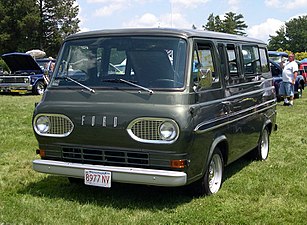Ford E-Series
| Ford E-Series | |
|---|---|
 | |
| Overview | |
| Manufacturer | Ford |
| Production | 1960–present (cutaway cab/stripped chassis only since 2015) |
| Model years | 1961–present (cutaway cab/stripped chassis only since 2015) 1961-2014 (passenger and cargo van) |
| Assembly | Lorain, Ohio, United States Avon Lake, Ohio, United States Oakville, Ontario, Canada[1] |
| Body and chassis | |
| Class | Full-size van |
| Chronology | |
| Predecessor | Ford F-series panel truck |
| Successor | Ford Transit (For United States, Canada, Mexico and the Philippines[2]) |
The Ford E-Series (also known as the Ford Econoline and Ford Club Wagon throughout various stages of its production) is a range of full-size vans produced by American automaker Ford. Introduced for the 1961 model year as the replacement for the Ford F-series panel van, the model line is currently in its fourth generation.
Produced in multiple design variations for both retail and commercial sale, the E-Series was developed as a van for either cargo or passenger use, and as a cutaway van chassis and stripped chassis (a chassis without bodywork). Since the 2015 model year, only the latter two designs are offered, as Ford replaced E-Series vans with the Ford Transit. From 1980 to 2014, the E-Series van was the best-selling full-sized van in the United States.[3]
The model line entered its 60th year of production for 2021, second only to the Ford F-Series (in production since 1948) within Ford Motor Company in terms of longevity. The E-Series is assembled by Ford at its Ohio Assembly facility at Avon Lake, Ohio, which has produced the model line since 1975. Prior to its closure, Lorain Assembly (Lorain, Ohio) assembled the model line from 1961 to 2005.
First generation (1961–1967)[]
| First generation | |
|---|---|
 1961–1967 Ford Econoline (customized) | |
| Overview | |
| Also called | Ford Falcon/Econoline Station Bus Ford Falcon Club Wagon Mercury Econoline (Canada) |
| Production | 1960–1967 |
| Body and chassis | |
| Body style | 4-door panel van 6-door van 8-door van 2-door pickup truck |
| Layout | FMR layout |
| Related | Ford Falcon |
| Powertrain | |
| Engine | 144 cu in (2.4 L) Falcon Six I6 170 cu in (2.8 L) Thriftpower Six I6 240 cu in (3.9 L) Truck Six I6 |
| Transmission | 3-speed manual 4-speed manual 3-speed C4 automatic[4] |
| Dimensions | |
| Wheelbase | 90.0 in (2,286.0 mm)[5] |
| Length | 168.3 in (4,274.8 mm) 186.3 in (4,732.0 mm) (Econoline Super Van) |
| Width | 75.0 in (1,905.0 mm)[5] |
| Height | 76.9 in (1,953.3 mm)[5] |
Ford released the first-generation Ford Econoline on September 21, 1960, for the 1961 model year.[3] Beginning development in 1957,[3] the model line served as a replacement for the Ford F-Series panel delivery (and the smaller Ford Courier sedan delivery). Three models were available, a cargo van, a passenger van (also sold under the Station Bus and Club Wagon names), and a forward-control pickup truck.[6]
Competing directly against the rear-engined Chevrolet Corvair van and Volkswagen Transporter, the Ford Econoline established multiple design precedents adopted by successive American vans, including the Chevrolet Van and Dodge A100. While also a forward-control vehicle, Ford introduced a midengined configuration.[7] To improve cargo access by creating a flat load floor and enlarging the rear doors, the engine was placed between the front seats.
Chassis[]
The first-generation Ford Econoline was based on the Ford Falcon compact car range.[6] To accommodate its 90-inch wheelbase (the shortest for a Ford since 1908), the Econoline adopted a midengined configuration, placing the engine behind the front axle; consequently, the layout precluded the use of a V8 engine.
The Econoline was initially powered by the 85 hp (63 kW) 144-cubic-inch inline-six (the standard engine of the Falcon); a 101 hp (75 kW) 170-cubic-inch inline-six was introduced as an option. For 1965, the 170 six became standard, with a 240 cubic-inch six introduced as an option. A three-speed manual was standard, with a Dagenham four-speed manual introduced for 1963 and discontinued in 1964; the 170-cubic-inch engine was offered with a three-speed automatic in 1964, and the larger two engines were both offered with a three-speed automatic as an option thereafter.[8]
In contrast to the Falcon, the Econoline was fitted with a solid front axle and a solid rear axle suspension with leaf springs for all four wheels.[9]
Body[]
In its body design, the Ford Econoline adapted several elements of the Volkswagen Type 2, while making major departures with other design features to accommodate its midengined layout. In line with Volkswagen, the Econoline positioned the front seats above the front axle, making it a cabover-style configuration (similar to the Jeep Forward Control). The grille placed below the headlights was a design feature borrowed loosely from the Ford Thames 400E (a predecessor of the Ford Transit).
The midengined placement enlarged the cargo area, as the engine compartment was located forward of the flat load floor. While Volkswagen marketed rear-engined vans in the United States until 1991, Chevrolet/GMC and Dodge both adopted the design of the Econoline, introducing midengined vans for the 1964 model year.
Through its production, the first-generation Ford Econoline was offered in several variants. Alongside the standard six-door cargo van, an eight-door version (adding two doors on the driver side) was added for 1963. For 1964, a panel van was introduced, deleting side loading doors altogether. For 1965, a "Super Van" extended-length body was introduced, extending the body 18 inches behind the rear axle. Econoline cargo vans (except panel vans) were offered with or without side windows in several configurations.
1963 Ford Falcon Club Wagon
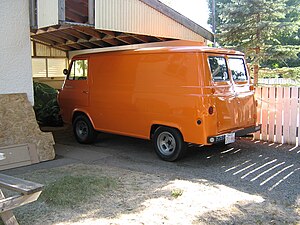
1961-1967 Ford Econoline cargo van (aftermarket wheels)
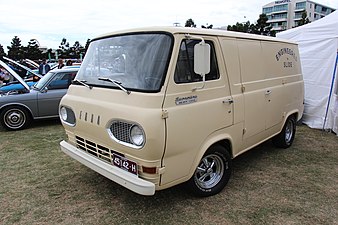
1964 Ford Econoline Heavy Duty cargo van (8-door version)

Ford Econoline TravelWagon (camper interior)
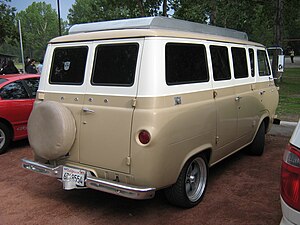
Ford Econoline TravelWagon (camper interior)

1965-1967 Ford Econoline Super Van (extended-length); aftermarket wheels
Variants[]
Alongside the Ford Falcon, the Ford Econoline was expanded into a product line including several vehicles. In Canada, the Econoline was marketed through both the sales networks of both Ford and Lincoln-Mercury (as a Mercury), to increase its presence outside of urban areas.
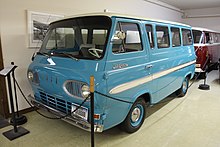
Passenger van[]
Introduced alongside the cargo van in 1961, Ford introduced two passenger variants of the Econoline (branded as part of the Falcon range). Alongside the Station Bus (branded as both a Falcon and Econoline), Ford marketed the Club Wagon. While the Station Bus was largely intended for commercial/fleet use, the Club Wagon was marketed as an alternative to station wagons.[10] A five-seat configuration was standard, with an eight-seat configuration offered as an option.
Pickup truck[]

Introduced as a bodystyle for 1961, the Ford Econoline pickup truck derived its body from the cargo van. Similar in configuration to the Chevrolet Corvair pickup, the Econoline pickup bed had no engine intrusion related to the engine compartment. While far shorter than the similar-GVWR F-100, the Econoline pickup was designed with a 7-foot-long pickup bed (sized between the two F-Series offerings). Two versions of the cab were offered, a standard "three-window" cab and an optional "five-window", which added wraparound windows to the cab corners.
The introduction of the 240-cubic-inch engine for 1965 necessitated a larger engine compartment, intruding slightly into the cargo bed (to provide clearance for the transmission bellhousing). The same year, a "Spring Special" package was offered as a trim option.
At the time of its launch, Ford projected the Econoline pickup truck to outsell the van, but buyers reversed the trend, with the van outselling the pickup truck nine-to-one.[11] The bodystyle ended production after the 1967 model year, remaining unique to the first generation.
Mercury Econoline[]

The first-generation Econoline was sold by Ford of Canada by both Ford and Lincoln-Mercury. When branding its truck offerings under the Mercury brand, Ford of Canada maximized its presence in rural area serviced by either Ford or Lincoln-Mercury (but not both). As with the Mercury M-series trucks, the Mercury Econoline was largely identical to its Ford namesake (differing primarily in badging); the model was marketed in Canada as a cargo and passenger van and a pickup truck.
For 1961, Ford of Canada began production Mercury-brand Econolines at Oakville Assembly in Ontario; later that year, Mercury Econoline pickup was shifted to Lorain Assembly in Ohio.[12] For 1962, production of the entire model line returned to Oakville. After 1965, production of the model line was sourced from the United States.[12]
Production numbers of Mercury Econolines were low; for example, 1,291 Mercury Econoline pickup trucks were built in 1965.[13] Following the 1968 model year, Ford of Canada ended the sale of Mercury-branded trucks, leaving the Mercury Econoline as the last Mercury-branded van until the 1993 Mercury Villager minivan.
Second generation (1968–1974)[]
This section needs expansion. You can help by . (December 2011) |
| Second generation | |
|---|---|
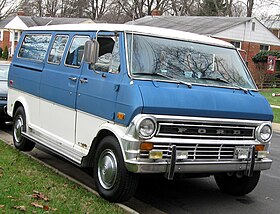 1972–1974 Ford Club Wagon | |
| Overview | |
| Production | 1968–1974 |
| Body and chassis | |
| Body style | 3-door van |
| Layout | FR layout |
| Powertrain | |
| Engine | 240 cu in (3.9 L) I6 300 cu in (4.9 L) I6 302 cu in (4.9 L) Windsor V8 |
| Transmission | 3-Speed Manual 3-speed Cruise-O-Matic automatic |
| Dimensions | |
| Wheelbase | SWB: 105.5 in (2,679.7 mm) LWB: 123.5 in (3,136.9 mm) |
As the result of a lengthy United Auto Workers strike in 1967, the launch of the second-generation Econoline van was delayed almost four months until January 1968. Instead of calling it a 1968 or 1968-1/2 model, Ford decided to call it the 1969 model. Shedding its Falcon roots, the second-generation Econoline became a heavier-duty vehicle, sharing many of its underpinnings with the F-series full-sized pickups.
Chassis[]
While the unibody construction of the previous-generation van was carried over, a major change was made in the overall layout in the body and chassis of the Econoline. To build a heavier-duty chassis, the midengined, forward-control layout was abandoned in favor of a front-engined layout with the axle placed forward; this also allowed the use of the "Twin I-Beam" front suspension used in the F-series trucks. The redesign in the configuration resulted in major growth; the wheelbase was increased 15 in (381.0 mm), while the 18 in (457.2 mm) longer long-wheelbase model became the largest full-sized van offered in North America at the time.
As they had become introduced as options in Dodge and Chevrolet/GMC vans, Ford introduced a V8 engine option into the powertrain line.
Body[]
With the change of chassis and axle configurations, the Econoline gained a conventional hood for engine access (though most engine access remained from the interior). To aid in engine compartment ventilation, the model was given a conventional grille, styled similar to the F series.
For 1971, the grille was redesigned to match the updated F series. For 1972, a sliding rear door became an option; introduced on a cutaway van chassis was the Hi-Cube van, a cab-chassis version of the Econoline with a box-van body. The introduction of the cab-chassis variant became popular in the recreational-vehicle industry (a Class C RV), a segment still dominated by the E series in the 2010s.
Interior[]
Inside of the Econoline, the shift of the engine location moved the engine housing from between the seats to in front of the driver and front passenger, under the windshield. While the Econoline cargo van remained, it was joined by an Econoline passenger van (replacing the Falcon van). To attract more buyers to passenger vans, Ford introduced two new trims of the passenger van, the Ford Club Wagon and Ford Club Wagon Chateau. Based on the long-wheelbase version, the Chateau had air conditioning, houndstooth fabric on all seats, an AM/FM sound system, and the option of 12-passenger seating.
- Second-generation models 1969–1974

1969-71 Econoline Window Van

1972 Econoline motorhome conversion
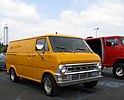
1973 Econoline 100

1974 Ford Econoline E-300 Quadravan
Third generation (1975–1991)[]
| Third generation | |
|---|---|
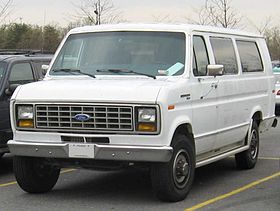 1983–1991 Club Wagon | |
| Overview | |
| Also called | Ford Club Wagon |
| Production | 1975–1991 |
| Body and chassis | |
| Body style | 3-door van |
| Layout | FR layout |
| Platform | Ford VN platform |
| Related | Ford Carousel |
| Powertrain | |
| Engine | 300 cu in (4.9 L) I6 302 cu in (4.9 L) Windsor V8 351 cu in (5.8 L) Windsor V8 460 cu in (7.5 L) 385 V8 6.9 L Navistar diesel V8 7.3 L Navistar diesel V8 |
| Transmission | 3-speed manual 4-speed manual 3-speed automatic 4-speed automatic 5-speed manual |
For 1975, the Econoline/Club Wagon were given a complete redesign. Based on an all-new chassis, Ford became the first American manufacturer to adapt body-on-frame construction to a full-size van.
The new-generation Econoline would become common not only in its own right, but as the basis for other vehicles. With a full frame, the Econoline became popular as a cutaway van chassis; the design served as a basis for many ambulances, and various types of trucks and buses. The shared drivetrain with the F-Series marked the beginning of aftermarket four-wheel drive conversions. During the 1970s, the Econoline became popular as a basis for van conversions. Using the sparsely-equipped Econoline cargo van as a basis, a luxurious interior was fitted, along with extensive customization of the exterior.
Chassis[]
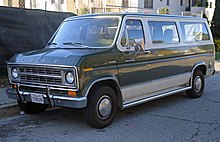


To increase the versatility of the full-size van line, the Econoline was developed using body-on-frame construction for the first time. In addition to increasing the strength of the chassis, the configuration allowed more commonality with the F-series trucks. As before, the Twin I-Beam front suspension was used. In its new configuration, the engine was moved further forward and lowered relative to the body. The van grew in size: the 124 inches (3,150 mm) short-wheelbase configuration was a half inch longer than the previous long-wheelbase chassis; the new long-wheelbase chassis was 138 inches (3,510 mm), the longest wheelbase full-size van sold until 1990. After the 1984 model year, the 124-inch wheelbase Club Wagon passenger van was discontinued, and the 124-inch wheelbase Econoline Cargo Van was discontinued after the 1990 model year, leaving the 138-inch wheelbase as the sole option.
In 1982, to increase the fuel economy of the Econoline without a major loss in engine output, Ford introduced the option of a 6.9 L IDI diesel V8 produced by International Harvester; in 1988, this was enlarged to 7.3 L. The diesel V8 engines were available only in Econoline 350s (or Club Wagons sold on the same chassis). The cutaway version was available with the larger (5.8 or 7.5 L) gasoline V8s or the diesel V8.[14]
Due to the popularity of automatic transmissions in full-size vans, Ford discontinued all manual transmissions after the 1989 model year. The column-shifted 3-speed departed after 1986, leaving the floor-shifted 4-speed overdrive manual as standard. The four-speed was replaced by a Mazda-sourced 5-speed M5OD for 1988.
Body[]
Unlike its predecessors, Ford designed the 1975 Econoline with a "two-box" layout. Similar to the Ford Transit of the time, the configuration moved the engine as far forward as possible and lower in the chassis than in its predecessor; although the hood was nearly twice as long, the hoodline was much lower. A higher degree of parts commonality with the F series made itself known in the bodystyling: the vent windows, taillights, bumpers, and wheels were common items between the two vehicles.
During its sixteen-year production run, the exterior of the Econoline/Club Wagon would remain nearly unaltered. In 1978, the Super Van/Super Wagon was introduced; based on the 138-inch wheelbase, it was a rear body extension allowing for extra cargo room or an extra row of seating (for up to 15 passengers). In 1979, a minor facelift updated the grille design; round headlights were replaced by rectangular units. In 1983, the Ford Blue Oval was added to the grille, replacing the "FORD" lettering on the hood.
Although the 1986 Ford Aerostar minivan would introduce styling far different from the Econoline, the basic styling of the full-size van would heavily influence the Ford Ranger (and its SUV offspring, the Ford Bronco II).
Interior[]
Inside, the redesign of the chassis expanded interior room, though the rear of the engine still remained between the front seats; an engine cover still provided access for servicing. Sharing many controls with the F series, the new design also improved interior ergonomics. In three body sizes, the Econoline was produced in a cargo van and passenger van, with the latter produced in three trim levels; base, Custom and Chateau. In addition, the Club Wagon was produced solely as a passenger van. After 1980, this was replaced by F-series nomenclature of XL and XLT. In line with the F-Series, the Econoline/Club Wagon was sold in 100/150/250/350 variants, with the Econoline 100 discontinued in 1983 (Club Wagon chassis variants were not denoted).
| 124" WB | 138" WB (Standard Van) | 138" WB (Super Van) | |
|---|---|---|---|
| Length | 186.8 in (4,745 mm) | 206.8 in (5,253 mm) | 226.8 in (5,761 mm) |
| Wheelbase | 124 in (3,149.6 mm) | 138 in (3,505.2 mm) | |
| Height | 79.1–79.9 in (2,009.1–2,029.5 mm) | 79.2–84.4 in (2,011.7–2,143.8 mm) | 80.9–84.8 in (2,054.9–2,153.9 mm) |
| Width | 79.9 in (2,029 mm) | ||
Fourth generation (1992–present)[]
| Fourth generation | |
|---|---|
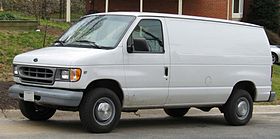 1997–2002 Ford Econoline | |
| Overview | |
| Also called | Ford Econoline (until 2006; name still used in Mexico according to Ford Mexico's website) Ford Club Wagon (until 1998) Ford Econoline Wagon (1999–2005) |
| Production | 1991–2014 (passenger/cargo van) 1991–present (cutaway/stripped chassis) |
| Model years | 1992–2014 (passenger/cargo van) 1992–present (cutaway/stripped chassis) |
| Body and chassis | |
| Body style | 3/4-door van |
| Layout | FR layout |
| Platform | Ford VN platform |
| Powertrain | |
| Engine |
|
| Transmission |
|
| Dimensions | |
| Wheelbase | 138 in (3,505 mm) |
| Length |
|
| Width | 79.3–79.9 in (2,014–2,029 mm) |
| Height | 80.7–84.1 in (2,050–2,136 mm) |
| Curb weight | 4,773 lb (2,165 kg) |
| Chronology | |
| Successor | Ford Transit |
For the 1992 model year, Ford introduced the fourth generation of the Econoline/Club Wagon. While the third-generation chassis was largely carried over, the body and interior underwent a complete redesign. As with the smaller Ford Aerostar, the fourth-generation model line was offered two body lengths on a common wheelbase.
The fourth-generation Econoline/Club Wagon underwent several revisions during its production. For 1999, to adopt a nomenclature closer in line to that of Ford full-size trucks, the Econoline was renamed the E-Series.
In June 2014, production of E-Series passenger and cargo vans was discontinued as sales of the Ford Transit began in North America. From 2015 onward, the E-Series has remained in production solely for commercial markets in cutaway-cab and stripped chassis configurations.[16] For the 2021 model year, the E-Series receives mechanical and functional updates to improve performance of second-party equipment; it remains in production solely as a commercial vehicle.[17]
Chassis specifications[]
The fourth-generation E-Series (Econoline/Club Wagon) shares the VN platform of the third-generation Econoline, introduced in 1975. Sharing many components with F-Series trucks, the E-Series retained the "Twin I-Beam" front suspension used by rear-wheel drive Ford trucks in North America from the 1960s to the early 1990s. The rear suspension was a live rear axle with rear leaf springs.
For the 2008 model year, the chassis underwent its largest revisions of the fourth generation. In an effort to improve handling and safety, larger brakes were added, improved steering, rollover stability control, and a higher GVWR.[18] The twin I-beam layout was retained, making it the second last Ford vehicle to use it.[19]
Powertrain[]
At its 1992 launch, the fourth-generation E-Series (Econoline/Club Wagon) carried over its powertrain line from the third-generation model line (sharing it with the ninth-generation F-Series). A 4.9L inline-six was standard, with a 5.0L V8, a 5.8L V8 offered as options. On 250 or 350-series vans, a 7.5L V8 and 7.3L Navistar diesel V8 were also optional; the diesel became turbocharged in 1993. During 1994, the IDI diesel was replaced by a 7.3L Ford Powerstroke diesel V8 (also sourced from Navistar).
For 1997, the E-Series underwent a revision of its engine lineup, retaining only the 7.3L diesel. Sharing its gasoline engines with the tenth-generation F-Series, a 4.2L V6 replaced the inline-6 and a 6.8L V10 replaced the 7.5L V8. The 5.0L V8 and the 5.8L V8 were replaced by 4.6L and 5.4L V8s, respectively.
For 2003, the 7.3L diesel was replaced by a 6.0L diesel from Navistar. While gaining an intercooler over its predecessor, due to the lack of airflow in the engine compartment (compared to Super Duty trucks), Ford had to detune the E-Series version of the 6.0L V8. For 2004, the 4.6L V8 became the standard engine (the first American full-size van with a standard V8 engine)
The 6.0L Power Stroke was offered until 2009 in the Ford Econoline vans (model year 2010), even though Ford Super Duty trucks were upgraded to the 6.4 version in 2007. Diesels were no longer offered after the 2010 model year. For 2009, the E-Series gained flexible-fuel capability with 4.6L and 5.4L engines (allowing them to use E85).
In May 2014, the final 4.6L V8 was produced for the E-Series, with the 5.4L V8 becoming the standard engine for 2015. For 2017, the 6.8L V10 replaced the 5.4L V8 as the standard engine, with a 6.2L V8 becoming the optional engine; along with flex-fuel capability, both engines were offered with options for conversion to CNG or LPG/propane.[20] For its 2021 model year revision, the E-Series cutaway cab adopts the 7.3L V8 of the 2020 Super Duty trucks as the only engine option.[17]
| Engine | Configuration | Production | Fuel type | Transmission |
|---|---|---|---|---|
| Ford Truck Six | 4.9 L (300 cu in) OHV I6 | 1992–1996 | Gasoline | 4-speed AOD automatic
4-speed E4OD automatic 4-speed 4R100 automatic 5-speed 5R110W automatic (TorqShift) |
| Ford Windsor V8 | 4.9 L (302 cu in) OHV V8 | 1992–1996 | ||
| 5.8 L (351 cu in) OHV V8 | 1992–1996 | |||
| Ford 385 Family V8 | 7.5 L (460 cu in) OHV V8 | 1992–1996 | ||
| Navistar 7.3L IDI V8 | 7.3 L (444 cu in) OHV V8 diesel | 1992 | Diesel | |
| 7.3 L (444 cu in) OHV V8 turbodiesel | 1993 | |||
| Navistar T444E V8 | 7.3 L (444 cu in) OHV V8 turbodiesel | 1994–2003 | ||
| Navistar VT365 V8
(Ford PowerStroke) |
6.0 L (365 cu in) OHV 4V V8 turbodiesel | 2004–2010 | ||
| Ford Essex V6 | 4.2 L (256 cu in) OHV V6 | 1997–2003 | Gasoline | |
| Ford Triton V8 | 4.6 L (281 cu in) SOHC 2V V8 | 1997–2014 | Gasoline
E85 | |
| 5.4 L (330 cu in) SOHC 2V V8 | 1997–2016 | |||
| Ford Triton V10 | 6.8 L (413 cu in) SOHC 2V V10 | 1997–2019 | Gasoline E85 Propane/LPG (optional) CNG (optional) | |
| Ford Boss V8 | 6.2 L (379 cu in) SOHC 2V V8 | 2017–2020 | ||
| Ford Godzilla V8 | 7.3 L (445 cu in) OHV 2V V8 | 2021-present | Gasoline CNG (Economy) |
6-speed automatic (TorqShift) |
Body[]
During its production, the fourth-generation E-series underwent minor revisions in 1997 and 2003, with a major revision in 2008; for 2021, the model line underwent an additional update.[17]
In line with the F-Series, the Econoline was sold in 150, 250, and 350 series, denoting ½, ¾, and 1-ton chassis (the Club Wagon was not designated by chassis size). The body was available in two lengths, with the extended-length version exclusive to the 250 (3/4-ton) and 350-series (1-ton) chassis for both cargo and passenger vans. The cargo van was sold as a two-passenger vehicle, with the passenger van sold in various configurations, including 5, 8, 9, 12, and 15 passengers.
Trim[]
During its production, the fourth-generation model line underwent several name changes. As with the previous generation, the Econoline was sold as both a cargo van and as a passenger van (Econoline Wagon) with the Ford Club Wagon sold only as a passenger van. For 1992 the luxury-oriented Chateau trim line of the Club Wagon, dormant since 1989, made a return, slotted above the XLT trim. For 1992, the Club Wagon Chateau was awarded Truck of the Year by Motor Trend.
Toward the end of the 1990s, Ford began to phase out the use of the Econoline and Club Wagon nameplates. For 1999, the Club Wagon nameplate was discontinued (in favor of Econoline Wagon). After the 2000 model year, the Econoline was renamed the Ford E-Series in the United States, in line with the Ford F-Series trucks (done by Ford Canada in 1995). For 2001, the Chateau was dropped, replaced by the E-150 Traveler; due to low sales, it was dropped after a single model year.
For 2011, to commemorate the 50th year of production, Ford offered a 50th Anniversary Edition of the E-Series. Offered on XLT Wagons, the option package was distinguished by blue metallic paint, embroidered seatbacks, and exterior badging.[21]
Model history[]
1992–1996[]

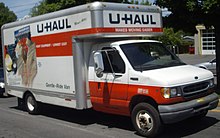
For the 1992 model year, the body of the Econoline underwent a complete redesign. In contrast to its GM and Dodge competitors, the two-box body configuration made a return. To optimize the aerodynamics of the van body, the hood was angled slightly downward and the windshield was raked back (though far less than the Aerostar). If specified, all side and rear window glass was flush-mounted to the body, along with wraparound taillamp lenses; flush-mounted composite headlamps were an option (standard on all Club Wagons). For 1992, the Econoline/Club Wagon became the first full-size vans produced with a center-mounted brake light.
When redesigning the interior of the E-series, the driver compartment underwent extensive modernization. While space between the front seats was again dominated by the front-mounted engine, a redesign of the engine cover freed up additional passenger room. Sharing controls and components with the F-Series and Aerostar, the model line became the first full-size van equipped with a standard driver-side airbag (except for 350-series models, exempted by their GVWR). The instrument panel received more legible instruments (but no tachometer); a 6-digit LCD odometer replaced the previous 5-digit analog unit.
For 1994, CFC-free R134a air-conditioning refrigerant was adopted beginning with September 1993 production.
For 1995, the taillamps were revised, removing the amber turn signals.
1997–2002[]
For 1997, the E-series underwent a revision of both its exterior and interior, largely to bring its appearance in line with other Ford trucks. The previous egg-crate grille was replaced by an eight-hole oval-shaped cutout (matching the Explorer and F-150).
The interior underwent a complete redesign, adopting an all-new dashboard. Following the adoption of dual airbags (for all versions), the "brick"-style steering wheel was replaced by one with a center-mounted horn. To improve the convenience of interior controls, rotary switches for climate controls were introduced, along with a double-DIN radio. The instrument panel was redesigned, reintroducing an analog odometer. The front seats underwent a redesign, relocating the seatbelt mounting to the B-pillars.

2003–2007[]
For 2003, the E-series underwent an exterior update, adopting the grille introduced by the 2002 E-550 Super Duty (see below). The new grille shifted the Ford Blue Oval emblem from the hood to the center of the grille (for the first time since 1991); based on trim, the grille was either dark gray or chrome. The front turn signal lenses were changed from clear to amber (their first change since 1992).
Coinciding with the exterior revision, the interior saw several updates. While the dashboard remained essentially unchanged, the engine cover was redesigned (including redesigned cup holders); the design now included a center-mounted glovebox (absent from the E-Series since 1974). For 2004, the instrument cluster was updated with a digital odometer; heavy-duty vans now offered a tachometer (as an option).
Ford E-550 Super Duty[]

For 2002, Ford introduced the E-550 Super Duty as the highest-GVWR version of the E-Series.[22] Offered solely in a cutaway-cab design,[22] the E-550 largely bridged the gap between the pickup truck-derived F-450/550 Super Duty and the F-650 medium-duty trucks.
Sharing a number of chassis components with the F-550 Super Duty, the E-550 was distinguished by a grille styled in line with Super Duty pickup trucks (with a three horizontal slots between two vertical openings). To accommodate the wider, heavier-duty front axle, the van body was fitted with a larger front bumper and plastic fender flares (shared with the F-550 truck). Several wheelbases were offered, ranging between 159.5 inches and 233.5 inches; as with the Super Duty and the E-350/450, the E-550 was powered by either a 6.8L V10 or a 7.3L V8 turbodiesel.[22]
Following the 2003 model year, Ford ended production of the E-550 Super Duty (the E-450 currently remains in production).

Some 2003 models have left the factory with 2002 leftover turn signals, but the majority of the 2003 models came with the newer, entirely amber turn signals.[citation needed]
2008–2014[]
In 2008, the E Series received a restyled front end design similar to that of the newly-introduced Ford Super Duty lineup of trucks. The interior design from the older model E Series was still used for the 2008 model year.
For the 2009 model year, Ford introduced a new interior design for the E Series. The instrument panel was now larger and easier to read, and included an enhanced message center that could display warning messages, and other useful information, and the front interior door panels were redesigned with 'E SERIES' branding embossed into the panels. Radios were also revised, with an auxiliary audio input jack being offered as standard equipment on all radios for the first time. The Ford Sync entertainment system, designed by Microsoft, and adding USB integration and hands-free Bluetooth calling and wireless A2DP stereo audio streaming capabilities was now also offered as an option. Finally, an optional touchscreen GPS navigation system radio was also offered, and included HD Radio on select models. Certain interior aspects, such as the seats, HVAC control panel, and steering wheel were carried over from the 2008 model year.
Starting with the 2011 model year, the 6.0L Ford Power Stroke Turbodiesel V8 engine was discontinued, and the E Series was no longer offered with a diesel engine.
2014 was the final model year for the E Series Cargo Van and Wagon (Passenger Van), as both models were replaced by the all-new Ford Transit Cargo Van and Wagon (Passenger Van) for the 2015 model year. At this time, the base 4.6L V8 Ford Modular engine was also discontinued, as the E Series became the last Ford product to use that engine. Due to its popularity with Recreational Vehicle (RV) and bus conversions, the E Series continues to be offered as either a Cab-and-Chassis (Chassis Cab) or Cutaway model in E-350 and E-450 Super Duty variants.
2015-2020[]

For the 2015 model year, Ford discontinued sales of the E-Series passenger and cargo vans, replacing them with the fourth-generation Ford Transit.[23]
While the E-Series had remained the best-selling vehicle in the full-size van segment since 1980,[24][25] the model line had seen little change since 1992 on a chassis introduced for the 1975 model year. At the time of its 2008 update, 95% of sales were to commercial or fleet users, with nearly half of production represented by cargo vans.[26]
From 2015 onward, the E-Series has remained in production entirely for commercial sale, with all examples produced as incomplete vehicles. The model line is currently offered in two configurations: cutaway-cab (open-cab, to be fitted with second-party rear body) and stripped-chassis (no body, to be fitted with complete second-party body).[27] Prior to 2019, the E-Series was also offered in a chassis-cab configuration.
Sold outside of North America since 1965, the Transit was introduced to the United States and Canada, offering increased fuel economy and additional body configurations over the E-Series.[23] Assembled in the United States, two of the four generations of the Transit have been co-developed by Ford in North America.
Following the discontinuation of E-Series passenger vans, the powertrain underwent a revision, with the 6.8L V10 becoming the only engine for 2016; a 6.2L V8 became offered as an option for 2017.
2021 revision[]

For the 2021 model year, Ford introduced an E Series with a new interior design from the Ford Super Duty. The base instrument cluster now included a 3.5-inch (3.5") monochromatic Productivity Screen, with a seven-inch (7.0") reconfigurable Thin Film Transistor (TFT) cluster being introduced as an option. The only available factory audio system option became a single-din A/M-F/M stereo radio with Bluetooth for hands-free calling and wireless stereo audio streaming via A2DP, and a USB input, featuring two front door-mounted speakers. The Ford corporate warning chimes were now included on the E Series, and the steering wheel featured a new design from the Ford Super Duty with more convenient controls. The new instrument panel design allows for the addition of new safety equipment that was previously not available on the E Series, including adaptive cruise control, a forward collision avoidance system, a lane departure warning system, automatic high-beam front headlamps, and automatic braking (these features are optional on the 2021 E Series). [28]
All 2021 Ford E Series models feature the same 7.3L naturally-aspirated gasoline V8 Ford Godzilla engine as the 2021 Ford Super Duty that replaces the previous 6.8L V10 Ford Modular engine (known as the "Triton" in Ford's truck lineup). The same six-speed automatic transmission that was used with the 6.8L V10 engine is also paired with the new 7.3L motor. The exterior design of the 2021 E Series changes little from its 2020 predecessor.
Production and sales[]
| Model year | US production |
|---|---|
| 1961 | 61,135[29] |
| 1962 | 76,938[29] |
| 1963 | 88,053[29] |
| 1964 | 83,079[29] |
| 1965 | 76,867[29] |
| 1966 | 84,180[29] |
| 1967 | 81,752[29] |
| Calendar year | US sales |
|---|---|
| 1997 | 186,690[30] |
| 1998 | 206,026[31] |
| 1999 | 202,024[32] |
| 2000 | 187,027 |
| 2001 | 159,565 |
| 2002 | 165,085[33] |
| 2003 | 161,721 |
| 2004 | 171,017[34] |
| 2005 | 179,543 |
| 2006 | 180,457 |
| 2007 | 168,722 |
| 2008 | 124,596 |
| 2009 | 85,735 |
| 2010 | 108,258 |
| 2011 | 116,874 |
| 2012 | 122,423 |
| 2013 | 125,356[35] |
| 2014 | 103,263[36] |
| 2015 | 50,788[37] |
| 2016 | 54,245[37] |
| 2017 | 53,304[38] |
| 2018 | 47,936[39] |
| 2019 | 45,063[40] |
| 1997-2019 sales | 3,005,718 |
See also[]
References[]
- ^ "Plant Information: Oakville Assembly Complex". Media.ford.com. Archived from the original on June 14, 2010. Retrieved May 31, 2011.
- ^ https://www.autoindustriya.com/auto-industry-news/ford-ph-goes-big-with-15-seater-transit-starts-at-php-2-3m.html
- ^ Jump up to: a b c Lee, Peter (2015). Ford Transit: Fifty Years. Crowood. ISBN 9781847978745. Retrieved 29 February 2016.
- ^ "Econoline.org". Econoline.org. Retrieved November 23, 2020.
- ^ Jump up to: a b c "1963 Ford Falcon Van brochure". Oldcarbrochures.com. Retrieved February 6, 2014.
- ^ Jump up to: a b Statham, Steve (1995). Ford Pickup Trucks. Motorbooks. pp. 71–72. ISBN 9780879389871. Retrieved 29 February 2016.
- ^ Gunnell, John (2005-10-25). American cars of the 1960s. 2005. p. 212. ISBN 9780896891319. Retrieved 29 February 2016.
- ^ "Econoline Transmissions". econoline.org.
- ^ "Directory Index: FMC Trucks-Vans/1961_Trucks-Vans/1961_Ford_Econoline_Van_Brochure". www.oldcarbrochures.com. Retrieved 2018-04-17.
- ^ "Directory Index: FMC Trucks-Vans/1963_Trucks-Vans/1963_Ford_Falcon_Van_Brochure". www.oldcarbrochures.com. Retrieved 2018-04-17.
- ^ Ernst, Kurt (19 January 2014). "Hemmings Find of the Day – 1961 Ford Econolpne pickup". Hemmings. Archived from the original on 22 January 2014. Retrieved 29 February 2016.
- ^ Jump up to: a b Truesdell, Rich (November 3, 2014). "Mercury Trucks Dare to Be Different". Vintage truck magazine. Archived from the original on 12 November 2014. Retrieved 29 February 2016.
- ^ "1965 Mercury Econoline pickup truck for sale". American Dream Cars. Retrieved 29 February 2016.
- ^ Mele, Jim (July 1990). "The New Models for 1991: Mid-Range Trucks". Fleet Owner. Vol. 85 no. 7. FM Business Publications. p. 70.
- ^ "1980 Ford Econolpne Van". Oldcarbrochures.com. Retrieved February 6, 2014.
- ^ Ramsey, Jonathon (April 18, 2014). "Ford E-series chassis cabs and cutaways to survive mass Transit onslaught". autoblog.com. Retrieved October 28, 2014.
- ^ Jump up to: a b c "New 2021 Ford E-Series Chassis Cab Debuts". Ford Authority. 2019-03-05. Retrieved 2019-12-28.
- ^ "Ford Rolls Out Super Duty-Inspired 2008 E-Series Vans". Edmunds Inside Line. March 9, 2007. Archived from the original on March 20, 2007.
- ^ "Ford's Twin I-Beam Front Suspension". www.hemmings.com. Retrieved 2019-03-07.
- ^ "New ergonomic and tech options enhance 2017 Ford Transit lineup; new engine for E-series stripped chassis, cutaway". Ford Motor Company Media Center. March 1, 2016.
- ^ "Ford's E-Series Vans Celebrate 50 Years of Success; 2011 lineup features special anniversary edition". Media.ford.com. September 13, 2010. Archived from the original on September 12, 2011. Retrieved May 31, 2011.
- ^ Jump up to: a b c "StackPath". www.fleetowner.com. Retrieved 2020-11-24.
- ^ Jump up to: a b "Ford's Transit Van continues E-Series' success". Detroit News.
- ^ "Key Milestones in 50-Year History of Ford E-Series, America's Favorite Full-size Van for 31 Years | Ford Motor Company Newsroom". 2011-01-18. Archived from the original on 2011-01-18. Retrieved 2019-10-08.
- ^ "Crossovers, Lincoln highlight Ford's 2007 sales performance; further growth expected in 2008". Media.Ford.com. January 3, 2009. Archived from the original on May 25, 2011.
- ^ "Ford Introduces The New 2008 E-Series Van". Blue Oval News. March 7, 2007. Archived from the original on 2007-10-08. Retrieved 2019-10-08.
- ^ "Ford Will Continue E-Series Cutaway/Stripped Chassis – PickupTrucks.com News". news.pickuptrucks.com. Retrieved 2016-06-22.
- ^ https://www.ford.com/commercial-trucks/e-series-cutaway/
- ^ Jump up to: a b c d e f g "Econoline Production Numbers". econoline.org. Retrieved 2020-11-23.
- ^ "Ford Reports Detailed Sales Results". www.theautochannel.com. Retrieved 31 July 2017.
- ^ Company, Ford Motor. "Ford Motor Company Topples December and Full Year U.S. Sales Records". www.prnewswire.com. Retrieved 31 July 2017.[better source needed]
- ^ "Ford Motor Company Sets New Full Year U.S. Sales Record". Theautochannel.com. Retrieved April 28, 2009.
- ^ "Ford's F-Series Truck Caps 22nd Year in a Row as America's Best-Selling Vehicle With a December Sales Record". Theautochannel.com. November 17, 2004. Retrieved April 28, 2009.
- ^ "Ford Achieves First Car Sales Increase Since 1999". Theautochannel.com. November 17, 2004. Retrieved April 28, 2009.
- ^ "Ford Motor Company Delivers Best Sales Year Since 2006; Ford Is Top Brand with Records for Fiesta, Fusion, Escape" (Press release). USA: Ford. January 3, 2014. Retrieved January 10, 2014.
- ^ "Ford Posts Best U.S. December Sales Results since 2005; Ford Once Again Best-Selling Brand and Best-Selling Vehicle" (Press release). USA: Ford. January 5, 2015. Retrieved February 12, 2015.
- ^ Jump up to: a b "Ford U.S. December Retail Sales up 5 Percent – a 12-Year High; Ford America's Best-Selling Brand for Seventh Year" (Press release). USA: Ford. January 4, 2017. Retrieved August 10, 2017.
- ^ https://media.ford.com/content/dam/fordmedia/North%20America/US/2018/01/03/dec17-sales.pdf
- ^ "Ford E-Series Sales Numbers, Figures, Results". Ford Authority.
- ^ https://media.ford.com/content/dam/fordmedia/North%20America/US/2020/01/06/sales-4q2019.pdf
External links[]
| Wikimedia Commons has media related to Ford E-Series. |
- Ford E-Series official websites: U.S.A. | Canada
- Ford E-Series Ambulance Packages official websites (U.S.A.): Van | Cutaway Chassis
- Vintage Truck Magazine 1962 Ford Econoline Van detailed article
- Ford Vans E series
- Mark's Econoline Page (Mainly about the 1961–1967 Econoline Pickups)
- Debut: 2008 Ford E-Series Vans (TheMustangNews.com – March 2007)
- Econoline.org - for first-generation Econolines from 1961-1967
- 1968–74 Ford Van Site
- Ford Econoline in television and film
- camperize.com—info about converting the E series into a campervan
- ThorMotorCoach.com—Major converter of E-series chassis into motorhomes
| show |
|---|
| show |
|---|
- 1960s cars
- 1970s cars
- 1980s cars
- 1990s cars
- 2000s cars
- 2010s cars
- Cars introduced in 1961
- Cab over vehicles
- Class 3 truck
- Class 4 truck
- Ford vehicles
- Mid-engined vehicles
- Motor vehicles manufactured in the United States
- Rear-wheel-drive vehicles
- School bus chassis
- Vans
- Minibuses
